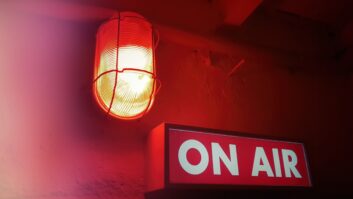USB VERSUS MINI JACK
I read with great disdain your small article in the Sept. 1 issue’s News Roundup about USB [Type-C] taking the place of the mini jack in audio applications.

iStockphoto/Dino77 If they go ahead and replace mini jacks with USB, my days in engineering are surely numbered. The average audio guy isn’t going to be able to simply wire up a cable for an innie or an outie and stick it in a hole to create an inexpensive, reliable audio interface for a lot of smaller broadcast equipment.
As I see it, until they get USB more stable and reliable, there’s no way it can be used in a pro audio setting. It’s bad enough that we have to use unbalanced audio and mini jacks for too much equipment interfacing as it is. I know it sounds like an oxymoron, but I’ll take a mini jack any day over USB.
Here’s just some of the USB interfacing flaws we already face today: USB can disassociate from a particular port when rebooting the device, so then your software mapping for the device goes to hell. Also, USB fails for no apparent reason because of fake power drains on the USB buss created by devices plugged into it, even when those devices aren’t taking power form the buss. And USB drivers don’t always operate at top speed; USB is as slow and clunky to implement as any serial device and impairs the transfers of high frequency analog signals.
I challenge you to find a USB oscilloscope that can measure broadcast frequencies, or even run correctly. USB scopes can barely do audio, let alone video or RF measurements.
And then there’s the expense of everything needing another USB adapter hanging out of the equipment to get it into, or out of, the device. It’s just more junk hanging off an already crowded table of equipment. How in the heck are you going to clip the USB converter on your hip along with you recorder and cellphone and everything else you have to carry?
The humble analog audio or video jack may seem low tech and not “hip” for modern day interfacing, but it sure is a lot cheaper, simpler and more reliable interface than putting another weak-kneed piece of digital tech between your signal and the transmission device or recorder.
How in the heck do you wire a microphone to go into a USB port without some tech know-how imported direct from China? At least analog cables are simple and can be serviced easily for opens or shorts. An analog cable requires no batteries or power sources to go bad.
When USB goes flooey, how does a jock service that on a live remote? People barely know how to use the tech we have already. And they want to add another thing in the chain to go wrong?
Also, is there going to be an analog to digital converter quality standard so we know what the heck were getting for frequency response? At least with analog, I pretty much know it’s all there if amplified correctly.
With a bad USB A/D converter, the junk could royally screw up the fidelity of what’s going into it, or worse, scramble the audio into digital mayhem, which already happens enough. At least with recorders, I mostly count on their A/D converters to be of reasonably high quality. If USB is used, I don’t think the A/D converters are going to be that great.
There’s more I could take issue with using the USB paradigm, but I’ll let this be enough for now.
Marvin Walther
Chief Engineer, Carroll Broadcasting
Program Director, WIOS(AM)
Tawas City, Mich.
FM CLASS C4
Regarding “Pai: Don’t Neglect the FM Band,” RW Oct. 12:

First, congratulations to Matthew Wesolowski of SSR Communications and WYAB(FM). His well-founded idea for a new FM Class C4 looks to have survived a bureaucratic black hole at the FCC, more than two years later after the proposal was initially offered. With Commissioner Ajit Pai’s encouraging and affirmative comments in support of C4 at the 2016 Radio Show, we will hopefully see positive movement on the proposal.
As Wesolowski has stated, a C4 class would primarily benefit several hundred FM stations in rural and smaller city markets. With the commission’s strong push in recent years for maintaining and increasing broadcast radio service in rural (and tribal) areas, including its firm prohibition of “rural into urbanized areas” station moves, a higher-power C4 class would make such service more financially viable for many commercial FM broadcasters in less densely populated areas.
I think the creation of a C4 class would also add greater interest and value to new FM allocations in future FCC FM auctions. As we saw in the previous FM Auctions 94 and 98, most of the new allocations were in rural and small town areas. In those auctions, many of the FM allocations justifiably received no bids because of their limited Class A signals, which only covered very sparsely populated areas.
Predictably, there have been some negative responses to the C4 proposal, and most notably from broadcast attorney John Garziglia. He argues that allowing hundreds of Class A FMs to upgrade to C4 would result in the forced displacement and termination of operations of an equal number of FM translators, many of which were only recently — and expensively — acquired by AM stations as part of the FCC’s “revitalization” efforts.
Full-power FM broadcasters have also invested tens and hundreds of thousands of dollars in FM translators to create HD sub-channel stations, which often provide valuable and interesting niche programming that can serve sizable audiences, despite the limited 250-watt ERP signals of the translators. I will agree with Garziglia’s reservations about potential interference from new C4 FMs to incumbent FM translators, but those concerns do not make the idea now dead and over with.
My further proposal, to assuage the legitimate concerns of the FM translator owners and operators and others like Garziglia, is that all FM translators that are already either operating, being constructed or applied for, would be specifically protected from displacement or termination of operations up until the day before a final report and order establishing an FM Class C4 is issued by the commission for publication in the Federal Register.
However, I would further require that this special FM translator protection be limited to licensees who are broadcasting a local signal, and not to the nationwide religious and other satellite programmers who are operating dozens to several hundred FM translators across the country and not providing truly local service. FM translators for these national satcasters would continue to retain their secondary service, subject to displacement by a local broadcaster looking to more effectively serve their local community.
With my suggestions above for protections for local owners and operators of FM translators, I strongly encourage the FCC to proceed with a Notice of Proposed Rulemaking to establish an FM Class C4. I hope that the other commissioners will see the value in the Class C4 proposal that Commissioner Pai does. Even two-plus years later, it is an idea whose time still remains, and strongly so.
Robert Lee
QXZ MediaWorks LLC
Corpus Christi, Texas
IT’S ABOUT VARIETY
Regarding “AM Revitalization Questions,” Reader’s Forum, Sept. 1 issue:
AM revitalized! This is not a complicated item. Give people what they want and they will listen in. The Class A stations serve a purpose … and that is variety!
If all that there were was local (like FM VHF), I wouldn’t bother to have a radio. The AM band is variety. I do listen to stations like WSM, WHO, CKLW, CFZM, WGN, WRCR, CFRX, WATR, WWCR, BBC-4 longwave for the program variety and news that you don’t normally hear (this is where shortwave is tops).
Digital noise has prevented reception of WBZ, KDKA and others. Their own noise drowns them out — if it’s not the hiss, it’s the grinding sound. Furthermore, to use this digital mode, the main AM is degraded; highs are cut as well as the lows. Result: low fidelity.
At this time, CFZM stands out. Just put the H.H. Scott tuner in wide mode, and who needs over-processed FM? Yes, they are mainly a music format. What a pleasant experience to listen to them at night.
The other problem is noise generated from cheap switcher supplies. That has to be stopped! Even electric toothbrush chargers and the big stuff like the new washing machines or motor-driven appliances with triac PWM drivers drown out even the car radio a mile away.
This rant is aimed at those that don’t feel the need for variety — which is sorely lacking in this age of mega stations and cookie cutter formats. That will and has already driven folks away from radio. Go back to block format, local talent — “radio unscripted.”
Mike Koscak
WA1MT

DON’T FORGET AM HD
I noticed that Radio World’s entire supplement “HD Radio From the Ground Up” was geared towards HD FM. The only mention of AM was in the Nautel advertisements.
There are still a few AM stations transmitting HD Radio; but since you don’t gain additional money-making channels (HD2 and up), you can’t get nearly as much benefit from it, and since radio is just about making money, it makes one believe that AM HD is not worth the effort.
Very few manufacturers are making AM/FM radios for home use that can pick up both analog and digital on both bands — lots of car radios, but no table or portable radios. How much more can it cost to put a $50 car radio, two loudspeakers and a small power supply into a box?
BestBuy had a portable HD Radio: FM only. It seems that when HD first came out, you could buy radios with AM-HD and FM-HD, but not now. At least one automaker has dropped AM entirely in their in-car entertainment systems because their vehicles create so much internal noise that they wipe out the AM reception. So it was easier and cheaper to just eliminate AM, and also AM-HD, rather than reduce the emissions from the vehicle computer systems.
I read a reader comment about trying to mandate HD Radio in all car radios, as FM was some 40 to 50 years ago. I bet there were no licensing fees then for FM; try to do that now with HD Radio and their fee structure.
Do you want some other technology to research? Try to buy a Wi-Fi/ internet tabletop radio. Every one has analog FM, possibly FM stereo, some have RDS. Absolutely none has AM. Some have iPod chargers and ways to interface smartphones, but no AM. They have two alarms and remote controls, but no AM. They can do wired or wireless networking, but no AM.
One side of me says AM HD was a bad idea from the beginning, and it should go away, but the other side says if it’s really going to stay, then it should have way more product support than it currently has.
Bob Meister
Hamden, Conn.




